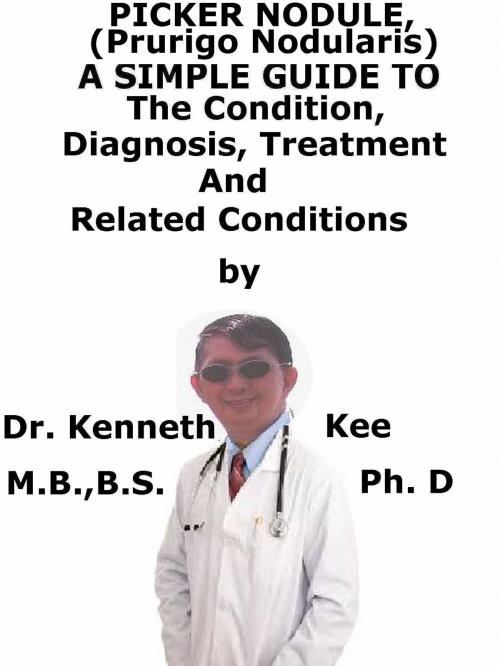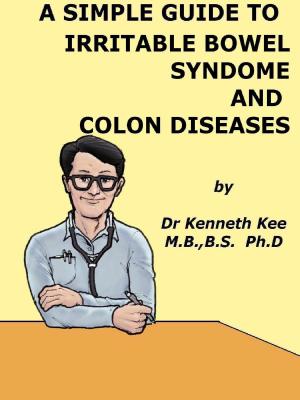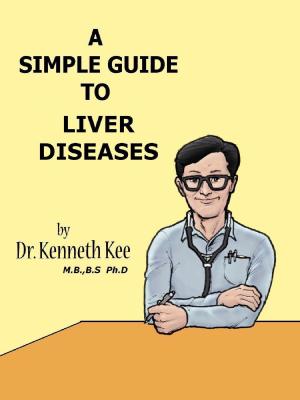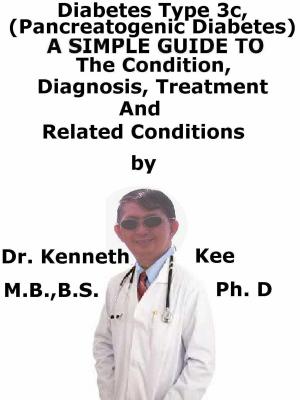Picker Nodule, (Prurigo Nodularis) A Simple Guide To The Condition, Diagnosis, Treatment And Related Conditions
Nonfiction, Health & Well Being, Medical, Specialties, Dermatology, Health, Ailments & Diseases, Skin| Author: | Kenneth Kee | ISBN: | 9781370130351 |
| Publisher: | Kenneth Kee | Publication: | September 8, 2017 |
| Imprint: | Smashwords Edition | Language: | English |
| Author: | Kenneth Kee |
| ISBN: | 9781370130351 |
| Publisher: | Kenneth Kee |
| Publication: | September 8, 2017 |
| Imprint: | Smashwords Edition |
| Language: | English |
Picker nodule (PN) is a skin disease featured by pruritic (itchy) nodules which normally occur on the arms or legs.
Patients often manifest with multiple ulcerated swollen lesions caused by scratching (skin picking).
PN is also known as Hyde prurigo nodularis, lichen corneus obtusus, prurigo nodularis.
Patients are often tormented by their symptoms which often prove difficult to control with conventional therapy
The most prominent symptom is the excessive itchiness of the skin lesion which makes the patient scratch or picks at the lesion hence the name Picker nodule.
Causes:
Atopy or allergy
Neurological
Psychological
Infection
The exact cause of Picker nodule is still unknown.
Symptoms:
Picker nodule patients are most often middle-aged to elderly.
Patients with Picker nodule normally have symptoms of a long-standing history of severe, continual pruritus.
Patients can reveal specific locations where they start feeling itchy and where dark-colored nodules develop soon after.
Mature nodules seldom enlarge or reduce in size.
Picker nodule is normally bilaterally symmetrical, with nodules that are either stable or rising in number.
The patient's medical history may be important for several disorders:
1. Hepatic or renal dysfunction
2. Local injury or insult to the skin
3. Infection
4. HIV/immunodeficiency
5. Hypothyroidism
6. Hematological malignancies
7. Anxiety or other psychiatric conditions
The patient's history often shows a long list of prescribed medicines (topical and oral) which normally have caused little or no relief of symptoms.
80% of patients have a personal or family history of atopic (allergic) dermatitis, asthma, or hay fever (compared with about 25% of the normal population).
In a true Picker nodule, a nodule forms before any itching begins.
Normally, these nodules are extremely itchy (pruritic) and are alleviated only by steroids.
Picker nodule lesions may show signs of picking of skin with flat, umbilicated, or crusted top.
Skin Nodules or papules are:
1. ≤2 cm in diameter.
2. Discrete.
3. Scaly.
4. Symmetrical distribution.
5. Firm.
6. Hyper-pigmented or occasionally purpuric (blue black or blood clot).
Lesions may number from 1-2 to hundreds.
When entering the examination room and while patients are describing the locations of the lesions, patients may scratch or rub the lesions rather than pointing to them.
Many Picker nodule patients seem very anxious, worried, or even obsessed with the nodules.
The diagnosis is based on the doctor’s observation and the presence of itching.
Often a skin biopsy is done to confirm the diagnosis.
Biopsy of the lesions is advised to rule out abnormal or atypical presentations of other disease such as squamous cell carcinoma, mycobacterial infections, fungal infections and cutaneous lymphoma.
A culture of at least one skin nodule will exclude staphylococcus infection, which has been considerably linked to atopic dermatitis
Lesion biopsies will normally show a high level of eosinophils (cause of allergy) in PN.
Treatment
Present available treatments of Picker nodule have had mild-to-moderate success at best.
Topical, oral, and intra-lesional corticosteroids have all been given to reduce inflammation and sense of itching and to soften and smooth out firm nodules.
Pulsed dye laser may decrease the vascularity of individual lesions
Cryotherapy with liquid nitrogen helps to decrease pruritus and flatten lesions
Cognitive behavioural therapy
Habit reversal therapy
Medicines used:
Antihistamines
Thalidomide
Lenalidomide
Opiate-receptor antagonists
Systemic retinoids
Psoralen combined with ultraviolet A (PUVA) treatment
The immunomodulators tacrolimus and pimecrolimus
Anxiolytic drugs
TABLE OF CONTENT
Introduction
Chapter 1 Picker Nodule
Chapter 2 Causes
Chapter 3 Symptoms
Chapter 4 Diagnosis
Chapter 5 Treatment
Chapter 6 Prognosis
Chapter 7 Psoriasis
Chapter 8 Skin Wart
Epilogue
Picker nodule (PN) is a skin disease featured by pruritic (itchy) nodules which normally occur on the arms or legs.
Patients often manifest with multiple ulcerated swollen lesions caused by scratching (skin picking).
PN is also known as Hyde prurigo nodularis, lichen corneus obtusus, prurigo nodularis.
Patients are often tormented by their symptoms which often prove difficult to control with conventional therapy
The most prominent symptom is the excessive itchiness of the skin lesion which makes the patient scratch or picks at the lesion hence the name Picker nodule.
Causes:
Atopy or allergy
Neurological
Psychological
Infection
The exact cause of Picker nodule is still unknown.
Symptoms:
Picker nodule patients are most often middle-aged to elderly.
Patients with Picker nodule normally have symptoms of a long-standing history of severe, continual pruritus.
Patients can reveal specific locations where they start feeling itchy and where dark-colored nodules develop soon after.
Mature nodules seldom enlarge or reduce in size.
Picker nodule is normally bilaterally symmetrical, with nodules that are either stable or rising in number.
The patient's medical history may be important for several disorders:
1. Hepatic or renal dysfunction
2. Local injury or insult to the skin
3. Infection
4. HIV/immunodeficiency
5. Hypothyroidism
6. Hematological malignancies
7. Anxiety or other psychiatric conditions
The patient's history often shows a long list of prescribed medicines (topical and oral) which normally have caused little or no relief of symptoms.
80% of patients have a personal or family history of atopic (allergic) dermatitis, asthma, or hay fever (compared with about 25% of the normal population).
In a true Picker nodule, a nodule forms before any itching begins.
Normally, these nodules are extremely itchy (pruritic) and are alleviated only by steroids.
Picker nodule lesions may show signs of picking of skin with flat, umbilicated, or crusted top.
Skin Nodules or papules are:
1. ≤2 cm in diameter.
2. Discrete.
3. Scaly.
4. Symmetrical distribution.
5. Firm.
6. Hyper-pigmented or occasionally purpuric (blue black or blood clot).
Lesions may number from 1-2 to hundreds.
When entering the examination room and while patients are describing the locations of the lesions, patients may scratch or rub the lesions rather than pointing to them.
Many Picker nodule patients seem very anxious, worried, or even obsessed with the nodules.
The diagnosis is based on the doctor’s observation and the presence of itching.
Often a skin biopsy is done to confirm the diagnosis.
Biopsy of the lesions is advised to rule out abnormal or atypical presentations of other disease such as squamous cell carcinoma, mycobacterial infections, fungal infections and cutaneous lymphoma.
A culture of at least one skin nodule will exclude staphylococcus infection, which has been considerably linked to atopic dermatitis
Lesion biopsies will normally show a high level of eosinophils (cause of allergy) in PN.
Treatment
Present available treatments of Picker nodule have had mild-to-moderate success at best.
Topical, oral, and intra-lesional corticosteroids have all been given to reduce inflammation and sense of itching and to soften and smooth out firm nodules.
Pulsed dye laser may decrease the vascularity of individual lesions
Cryotherapy with liquid nitrogen helps to decrease pruritus and flatten lesions
Cognitive behavioural therapy
Habit reversal therapy
Medicines used:
Antihistamines
Thalidomide
Lenalidomide
Opiate-receptor antagonists
Systemic retinoids
Psoralen combined with ultraviolet A (PUVA) treatment
The immunomodulators tacrolimus and pimecrolimus
Anxiolytic drugs
TABLE OF CONTENT
Introduction
Chapter 1 Picker Nodule
Chapter 2 Causes
Chapter 3 Symptoms
Chapter 4 Diagnosis
Chapter 5 Treatment
Chapter 6 Prognosis
Chapter 7 Psoriasis
Chapter 8 Skin Wart
Epilogue















